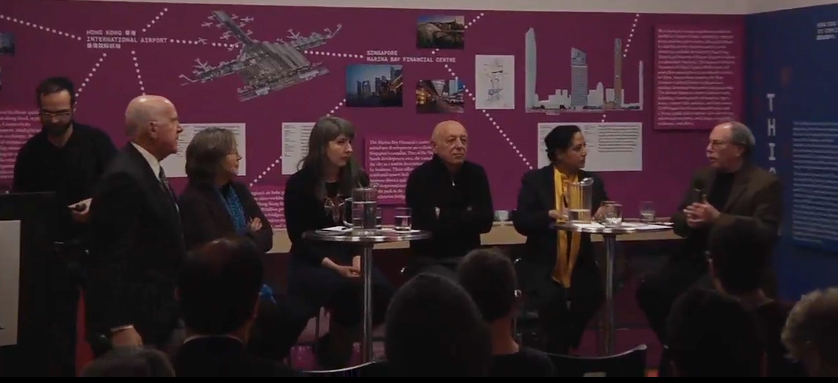by Camila Schaulson Frenz
On 12.11.13, following on the heels of the AIANY 2014 Board Inaugural, the Center for Architecture hosted “The Role of Engaged Learning in Building Better Cities,” the second part of a symposium related to the exhibition “People Building Better Cities.” With its focus on increasing participation, the program also functioned as the informal launch of “Civic Spirit: Civic Vision,” the presidential theme of 2014 AIANY President Lance Jay Brown, FAIA. Noting this fortuitous scheduling of events, Brown also took advantage of his introduction to share his own experiences with participatory design, including his work on a1968 research project at Princeton University for a planning and design workbook for community participation.In another look to the past, Tony Schuman, professor of architecture and design at the New Jersey Institute of Technology, kicked off the presentations with a brief history of how architecture schools and practices have engaged social issues. Beginning with the activism of the 1960s, spurred on by the likes of Henri Lefebvre and Robert Goodman, through The Architects’ Resistance’s 1989 walk-out on a regional AIA conference and the Architects, Designers, and Planners for Social Responsibility’s campaign to change the AIA’s Statement of Ethics, Schuman tracked the organizational efforts of architects around pressing social issues. Moderator Elliott Sclar, director of the Center for Sustainable Urban Development, insightfully pointed out that many of these past activities involved “stopping things” – fighting disruptive urban renewal schemes. The pertinent question today, however, is how do we now create architecture that makes a difference? How do we make sure the discipline remains socially relevant?
For many of the evening’s speakers, including Nabeel Hamdi, professor at Oxford Brookes University, this has more to do with procedure than with the end product. For one part, in order to be effective, efforts must have long-term effects, claimed Geeta Mehta, professor at Columbia University’s Graduate School of Architecture, Planning and Preservation. More than viewing a final design as a solution, engaged practices focus on creating sustainable frameworks that can be appropriated and replicated by underprivileged groups.
Because engaged practices often view the environment holistically – as more than just the built form – speakers also emphasized the importance of interdisciplinary work. According to Schuman, “Architects are amateurs in almost everything they touch upon; they are only experts at rendering.” This condition requires working closely with other experts. And to Christine Gaspar, executive director of the Center for Urban Pedagogy (CUP), an organization that uses the power of design and art to create engaging informational materials, there is no expertise like that of the community. Hamdi seconded this view, paralleling the community to the engineer: “In the same way that one would never dare put up a complex building without the advice of a civil engineer, how dare we deal with the complexity of some of the places we are talking about… without the experts that are out there?”
Engaging, however, is easier said than done. According to Hamdi, in the geography of professional practice, architects must choose between the dry high ground, focusing on abstract formal issues, or trudge through the muck, the swamp of issues down below. Mehta pointed out the disconnect between the projects featured in “People Building Better Cities” and those in the adjacent Hines Gallery, part of the Center’s “Practical Utopias” exhibition, asking: “Why are we not creating instruments to demand that there be more connections?” To Schuman, the complexities of participative planning are exacerbated by the state of architectural education, which privileges “digital dexterity and formal qualities.”
Despite these issues, the speakers took pride in their successes. Anna Rubbo, founder of Global Studio, noted that the global education program has run six times, and has involved more than 600 participants, 66 universities, and 11 practices across 30 countries. The success of CUP’s poster series on street vendor codes, produced in collaboration with the Street Vendor Project, managed to drastically reduce fines for vendors.
While wading in the muck may be time-consuming and difficult, the rewards are well worth the effort. An enthusiastic audience member summed it up best: “I think we’ve come to expect…the instant gratification that you get from a Rhino or AutoCAD program. To become a mature architect takes years and years of practice. I think the same is true of an architect…who works in the swamp. We’re dealing with very entrenched structural issues that take a long time to nudge along for some change, [but] I wouldn’t trade it for the world.”
Event: The Role of Engaged Learning in Building Better Cities
Location: Center for Architecture, 12.11.13
Speakers: Tony Schuman, Professor, Architecture and Design, New Jersey Institute of Technology; Geeta Mehta, Professor, Graduate School of Architecture, Planning and Preservation, Columbia University; Christine Gaspar, Executive Director, Center for Urban Pedagogy; Nabeel Hamdi, Professor, Oxford Brookes University; Anna Rubbo, Founder, Global Studio, and Research Scholar, Consortium for Sustainable Urban Development, Columbia University; Elliott Sclar, Director, Center for Sustainable Urban Development, Columbia University (moderator); and Lance Jay Brown, FAIA, AIANY 2014 President
Organized by: Center for Architecture, Global Studio, and Center for Sustainable Urban Development, Columbia University


